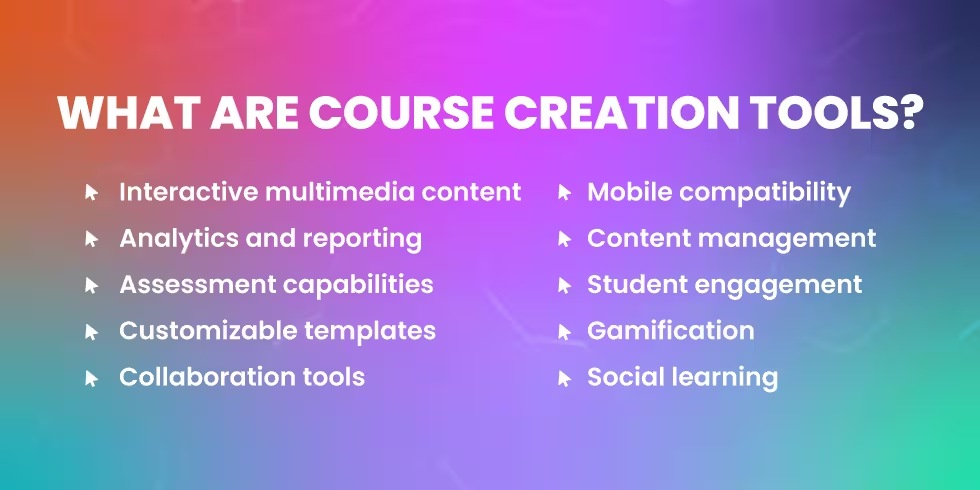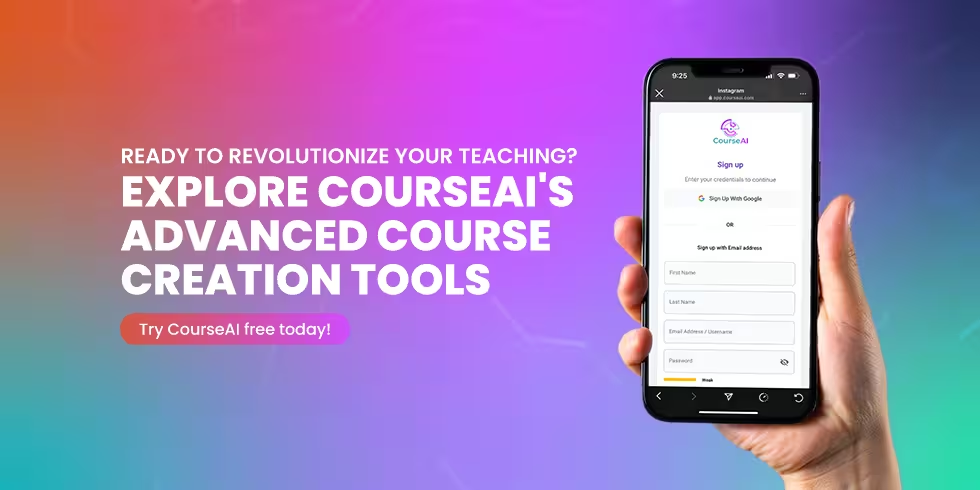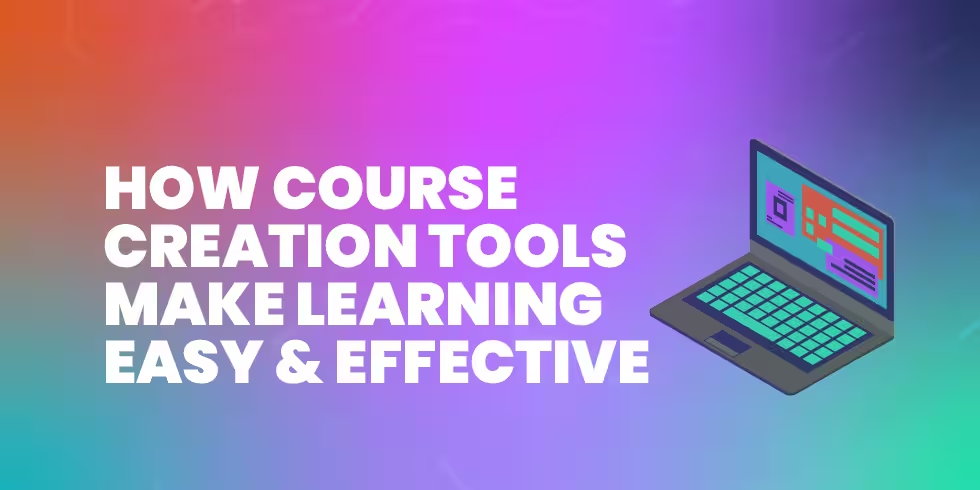The landscape of education is evolving rapidly, and advanced course creation tools are at the forefront of this change. These tools are revolutionizing how educators develop and deliver content, making learning more accessible, engaging, and effective.
In this blog, we will explore how course creation tools are shaping the future of education and why they are essential for modern educators.
What are Course Creation Tools?

Course creation tools are software applications designed to help educators develop, manage, and deliver educational content.
These tools offer a range of features, from interactive multimedia content to analytics and assessment capabilities. Here’s what CourseAI offers:
- Interactive multimedia content: Incorporate videos, audio, infographics, and simulations.
- Analytics and reporting: Track student performance, engagement, and progress.
- Assessment capabilities: Utilize quizzes, assignments, and exams for evaluation.
- Customizable templates: Develop professional and visually appealing courses quickly.
- Collaboration tools: Enable instructor collaboration and sharing of best practices.
- Mobile compatibility: Access courses on various devices, including smartphones and tablets.
- Content management: Organize and manage educational content efficiently.
- Student engagement: Enhance interaction with discussion forums and live chats.
- Gamification: Implement game-like elements for interactive learning.
- Social learning: Foster community learning through peer feedback and discussions.
The Benefits of Course Creation Tools
Enhanced Engagement
Course creation tools incorporate multimedia elements such as videos, quizzes, and interactive simulations. These features make learning more engaging and help retain students’ attention, leading to better comprehension and retention of material.
Accessibility and Flexibility
With course creation tools, learning is no longer confined to the traditional classroom. Students can access courses anytime, anywhere, using various devices. This flexibility allows learners to study independently and according to their schedules.
Personalized Learning
Advanced course creation tools offer personalized learning paths based on individual student performance. By analyzing data, these tools can adapt content to meet the unique needs of each learner, enhancing the overall educational experience.
Streamlined Content Creation
Course creation tools simplify the process of developing educational content. Educators can easily design and organize course materials, collaborate with peers, and update content as needed. This efficiency allows instructors to focus more on teaching and less on administrative tasks.
Improved Assessment and Feedback
These tools provide robust assessment features, enabling educators to create various types of quizzes and assignments. Instant feedback helps students understand their progress and areas needing improvement, fostering a continuous learning process.
Key Features of Modern Course Creation Tools
Interactive Content
Incorporate videos, audio, infographics, and interactive simulations to create a dynamic learning environment. This will engage students in a more immersive and interactive way and enhance their overall learning experience.
Example: Medical training courses can use virtual reality simulations to allow students to practice surgical procedures without the need for physical resources, saving significant costs and providing a safer learning environment.
This approach not only makes learning more engaging but also ensures that students can practice repeatedly, leading to better retention and understanding.
Analytics and Reporting
Comprehensive analytics and reporting tools track student performance, engagement, and progress. By providing valuable insights into learning outcomes and areas for improvement, creators ensure data-driven decisions.
Example: Online universities have the ability to implement detailed analytics to identify students who are struggling with specific concepts.
Addressing these areas early on with course creation tools reduces dropout rates and improves overall course completion rates, thereby saving costs associated with student retention efforts and enhancing educational outcomes.
Collaboration Tools
Integrated collaboration features enable instructors to collaborate on course development and share best practices. The result is an engaged community of learning and continuous improvement among educators.
Example: In a real-world scenario, a group of educators from different schools can use collaboration tools to co-create a comprehensive curriculum for a nationwide STEM program.
This not only saves time and resources by reducing redundant work but also pooling together diverse expertise, resulting in a higher-quality educational program that benefits students across multiple regions.
Customizable Templates
Use pre-designed templates to quickly create professional and visually appealing courses. These templates allow for easy customization to match specific educational needs and branding requirements, streamlining the course creation process.
Example: A corporate training department now has the ability to roll out a new compliance course in record time by utilizing customizable templates.
This not only saves them the cost of hiring external designers but also ensures that the course is consistently branded and tailored to the company’s needs, enhancing the overall learning experience for employees.
Mobile Compatibility
Ensure that courses are accessible on various devices, including smartphones and tablets, for learning on the go, providing flexibility and convenience for students to access their courses anytime, anywhere.
Example: As a use-case, imagine a language learning app that leverages mobile compatibility to allow users to continue their lessons during their daily commutes or while traveling.
This increased user engagement and completion rates, as learners could easily integrate study sessions into their busy schedules. The flexibility of mobile access also means that the company could reach a wider audience, expanding its market and increasing revenue.
Case Studies: Success Stories with Course Creation Tools
University Programs
Many universities have adopted course creation tools to enhance their online learning programs. These tools have enabled institutions to offer a wider range of courses, attract more students, and provide a better learning experience.
Corporate Training
From startups to Fortune 500 companies, course creation tools are already being deployed to develop better employee training programs. These tools help businesses deliver consistent, high-quality training that improves employee skills and productivity.
Nonprofit Organizations
Nonprofits leverage course-creation tools to educate their communities and volunteers, making it easier to disseminate knowledge and skills, and driving greater impact. For instance, many nonprofits have used platforms like CourseAI to create free and paid online courses, which reduce costs associated with physical materials, travel, and in-person instruction.
Conclusion

Innovative course creation tools are shaping the future of education. By embracing these tools, educators can create engaging, accessible, and personalized learning experiences that cater to their students’ diverse needs. As we move forward, the continuous evolution of these tools will ensure that learning remains a dynamic and enriching process.
Ready to revolutionize your teaching? Explore CourseAI’s advanced course creation tools and see how they can transform your educational content. Learn more about our tools and start creating engaging and effective courses today!

